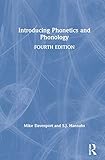Introducing phonetics and phonology / Mike Davenport and S.J. Hannahs.
Material type: TextPublication details: NY : Routledge, c2020.Edition: Fourth editionDescription: pages cmISBN:
TextPublication details: NY : Routledge, c2020.Edition: Fourth editionDescription: pages cmISBN: - 9780815353300
- 9780815353294
- 414 23 DAV
- P217 .D384 2020
| Item type | Current library | Collection | Call number | Status | Date due | Barcode |
|---|---|---|---|---|---|---|
 General Books
General Books
|
CUTN Central Library Languages | Non-fiction | 414 DAV (Browse shelf(Opens below)) | Available | 47468 |
Previous edition: London: Hodder Education, [2010].
Includes bibliographical references and index.
List of tables
List of figures
Preface to the first edition
Preface to the second edition
Preface to the third edition
Preface to the fourth edition
The International Phonetic Alphabet
1. Introduction
1.1 Phonetics and phonology
1.2 The generative enterprise
Further reading
2. Introduction to articulatory phonetics
2.1 Overview
2.2 Speech sound classification
2.3 Suprasegmental structure
2.4 Consonants versus vowels
Further reading
Exercises
3. Consonants
3.1 Stops
3.2 Affricates
3.3 Fricatives
3.4 Nasals
3.5 Liquids
3.6 Glides
3.7 An inventory of English consonants
Further reading
Exercises
4. Vowels
4.1 Vowel classification
4.2 The vowel space and Cardinal Vowels
4.3 Further classifications
4.4 The vowels of English
4.5 Some vowel systems of English
Further reading
Exercises
5. Acoustic phonetics
5.1 Fundamentals
5.2 Speech sounds
5.3 Cross linguistic values
Further reading
Exercises
6. Above the segment
6.1 The syllable
6.2 Stress
6.3 Tone and intonation
Further reading
Exercises
7. Features
7.1 Segmental composition
7.2 Phonetic versus phonological features
7.3 Charting the features
7.4 Conclusion
Further reading
Exercises
8. Phonemic analysis
8.1 Sounds that are the same but different
8.2 Finding phonemes and allophones
8.3 Linking levels: rules
8.4 Choosing the underlying form
8.5 Summary
Further reading
Exercises
9. Phonological alternations, processes and rules
9.1 Alternations versus processes versus rules
9.2 Alternation types
9.3 Representing phonological generalisations: rules and constraints
9.4 Overview of phonological operations
9.5 Summary
Further reading
Exercises
10. Phonological structure
10.1 The need for richer phonological representation
10.2 Segment internal structure: feature geometry, underspecification and unary features
10.3 Autosegmental phonology
10.4 Suprasegmental structure
10.5 Conclusion
Further reading
Exercises
11. Derivational analysis
11.1 The aims of analysis
11.2 A derivational analysis of English noun plural formation
11.3 Extrinsic versus intrinsic rule ordering
11.4 Evaluating competing analyses: evidence, economy and plausibility
11.5 Conclusion
Further reading
Exercises
12. Constraint-based analysis
12.1 Introduction to Optimality Theory
12.2 The aims of analysis
12.3 Modelling phonological processes in OT
12.4 English noun plural formation: an OT account
12.5 Competing analyses
12.6 Conclusion
Further reading
Exercises
13. Constraining the model
13.1 Constraining derivational phonology: abstractness
13.2 Constraining the power of the phonological component
13.3 Constraining the power of OT
13.4 Conclusion
Further reading
Glossary
References
Subject index
Varieties of English index
Languages index
"Intended for the absolute beginner, Introducing Phonetics and Phonology requires no previous background in linguistics, phonetics or phonology. Starting with a grounding in phonetics and phonological theory, the book provides a base from which more advanced treatments may be approached. It begins with an examination of the foundations of articulatory and acoustic phonetics, moves on to the basic principles of phonology, and ends with an outline of some further issues within contemporary phonology. Varieties of English, particularly Received Pronunciation and General American, form the focus of consideration, but aspects of the phonetics and phonology of other languages are discussed as well. This new edition includes: revised exercises and examples; additional coverage of typology, autosegmental phonology, and articulatory and acoustic phonetics; broader coverage of varieties that now features Australian English; and an extended chapter 7 that includes more information on the relationship between phonetics and phonology. Introducing Phonetics and Phonology 4th Edition remains the essential introduction for any students studying this topic for the first time. This new edition has been revised and updated throughout in light of advances in the field, without compromising the overall aims of the text: to provide an accessible introduction to phonetics and phonology"--


There are no comments on this title.